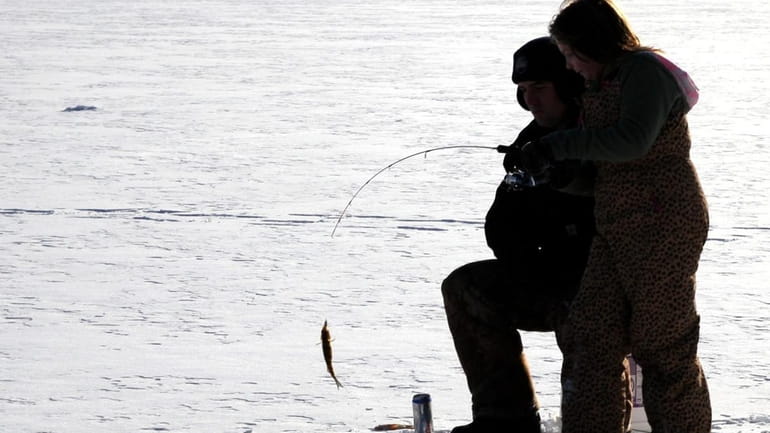Ice fishing on Long Island lakes and ponds

Kevin Slade, of Wading River and Julia Latremore, 10, of Valley Stream, ice fishing at Deep Pond in the Schift Scout Reservation in Wading River. (Jan. 9, 2010) Credit: Photo by Ed Betz
It's an early January morning and the wind is honking out of the north. The thermometer reads 23 degrees but Dave Lengyel is breaking a sweat.
"This is fun!" he shouts while jogging across the ice toward a small, orange flag. "I love it when the bite is hot."
Lengyel and buddies Eric Latremore and Kevin Slade, all of whom work for the New York State Department of Environmental Conservation, along with Eric's wife, Katie, are ice fishing on Deep Pond in Wading River and they are having a blast. By lunchtime, they've hauled a quartet of brown trout plus 20 or so tasty yellow perch from the frigid waters while enjoying plenty of laughs and exercise.
"Sure it's cold," says Eric Latremore, 30, who lives in Ridge and has been ice fishing since age 6, "but this is great for spending time with friends and family while breaking the monotony of the winter season."
SAFETY FIRST
As is the case with ice skating, safe ice is thick ice. The golden rule is to stay off until it is at least four inches thick. Never drive a motor vehicle onto the ice - and never venture onto unknown ice alone. Beginners should make it a point to fish near other anglers.
While a lake does not have to be frozen fully across for ice fishing, stay well clear of open water and be wary of thin ice that may develop where rivers and streams enter or exit a lake. When initially stepping out onto the ice, anglers should stand several feet apart to spread their weight. All groups should carry a safety line that can be tossed to someone who falls through.
NEED TO KNOW
Ice fishing season generally runs from late December through mid-February on Long Island. Waters with depths of at least eight feet produce best, with morning and late afternoon being prime time.
A freshwater fishing license is required for ages 16 or older (see www.dec.ny.gov for full fishing regulations).
The maximum diameter for ice fishing holes is eight inches. Before leaving the ice, be sure to mark each hole with a pile of snow so its location will be obvious to skaters, ice-boaters and others.
HOW TO DRESS
Ice fishing is fun, but it can also be cold. Dress in layers as you might for skiing, including thermal undergarments, a sweatshirt or turtleneck sweater and a coat that will block the wind. Top off with a knit hat, insulated, waterproof boots, thermal socks and water-resistant gloves. Dry rags, for cleaning your hands after handling the catch or baiting hooks, are a key to staying comfortable.
WHERE TO GO
Anglers are allowed to fish through the ice on many Suffolk County lakes and ponds, but ice fishing is prohibited in both Nassau and Suffolk county parklands. The following spots make great starting points.
ARTIST LAKE: Route 25, Middle Island
What you might catch: Crappies, bluegills, yellow perch, pickerel, largemouth bass
Perfect for beginners and those with kids. This lake freezes easily and is likely to host other ice fishermen from whom to learn. Set up at the middle of the lake in front of the parking area so it's just a short hike to the car if you need to get warm. Panfish provide action, while pickerel and bass offer trophy possibilities.
What you might catch: Brown and rainbow trout, yellow and white perch, bluegills, largemouth bass, pickerel
Cold, deep and buffered from the wind, this lake freezes for at least a few days most winters. It's a 100-yard hike from the parking area to the ice. Drill holes along the south side, 100 to 200 feet from the shore. Space the holes at least ten feet apart. The trout, especially, bite best before 10 a.m.
LAKE RONKONKOMA: Victory Drive Launch Ramp, Ronkonkoma
What you might catch: White and yellow perch, walleye, crappie, bluegill, largemouth bass
It's not often that Long Island's largest lake freezes over but when it does, smallish perch, crappie and bluegills feed aggressively. The walleye and bass, if you find them, can top six pounds. Fish near the Victory Drive Ramp, in the northwest corner, or in front of the Islip and Brookhaven Town beaches.
ICE FISHING GEAR
Ice fishermen use specialized gear, so you'll probably need to pick up a few items before heading out.
Jig pole ($10-$20): Tiny ice fishing rods can be purchased, or make your own using duct tape to attach an ultralight spinning reel to the rod tip section of a two-piece panfish or trout rod.
Tip-ups ($10-$12 each): This simple device allows the angler to set a small spool of line in the water below the ice with a spring-set flag locked in position. When a fish bites, it pulls the line and the spool rotates to "tip up" the flag. The angler then hand-lines the fish through the ice as if bringing a crab to net with a drop line.
Ice auger ($70): Used to drill fishing holes through the ice, hand augers are fine for most Long Island applications. In colder climates, gas-powered or battery operated augers may be necessary.
Ice scoop ($5): Basically a slotted spoon, ice scoops are used to keep ice fishing holes free of new forming ice.
Needle-nosed pliers: Use them to remove hooks from your catch.
Sled: Pile your ice fishing gear into a 5-gallon bucket and place it on a sled. Add a towrope and slide it along to your presumed fishing hot spot. A circular red plastic sled works well.
Bait: Live minnows ($6 per dozen) are preferred, but wax worms and pieces of night crawler also work. Popular lures include small teardrop jigs, tiny soft-tailed jigs and Swedish Pimples.
